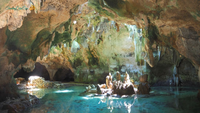Navdarism: Difference between revisions
m (→Avowal) |
mNo edit summary |
||
| Line 3: | Line 3: | ||
[[Category:Navdarism]] | [[Category:Navdarism]] | ||
Navdarism ('' | '''Navdarism'''({{wp|Persian language|Pouremanian}}: ''Nawdhariyat''), also known as '''Daena''' ({{wp|Persian language|Pouremanian}}: ''Daēnā'') is the [[Aeia|world's]] [[List of religions in Aeia|second-largest religion]], and one of the world's oldest continuously practiced {{wp|religion|religions}}. Navdarism is a {{wp|Monism|monistic}} faith, with elements of {{wp|henotheism}} and {{wp|atheism}}, centered on an eschatological cosmology dealing with self-salvation and spiritual liberation. It also encompasses a variety of traditions, beliefs and spiritual practices largely based on the original teachings of [[Nawdhar]]. It originated in ancient [[Poureman]] in the 11th century BCE, and, after a period of intense suppression, spreading through much of [[Sifhar]], [[Arabekh]], [[Majula]], and [[Catai]]. Three major extant branches of Navdarism are generally recognized: [[Benayine]] ({{wp|Persian language|Pouremanian}}: {{literal translation}} ''Seeing through the Mirror''), [[Mehtaraina]] ({{wp|Persian language|Pouremanian}}:''Order of the Elders''), and [[Vasborya]] ({{wp|Persian language|Pouremanian}}:{{literal translation}} ''Dancing on the Tower'') | ||
==Terminology== | ==Terminology== | ||
Revision as of 01:13, 28 March 2020

| Part of a series on |
| Zohism |
|---|
 |
Navdarism(Pouremanian: Nawdhariyat), also known as Daena (Pouremanian: Daēnā) is the world's second-largest religion, and one of the world's oldest continuously practiced religions. Navdarism is a monistic faith, with elements of henotheism and atheism, centered on an eschatological cosmology dealing with self-salvation and spiritual liberation. It also encompasses a variety of traditions, beliefs and spiritual practices largely based on the original teachings of Nawdhar. It originated in ancient Poureman in the 11th century BCE, and, after a period of intense suppression, spreading through much of Sifhar, Arabekh, Majula, and Catai. Three major extant branches of Navdarism are generally recognized: Benayine (Pouremanian: lit. Seeing through the Mirror), Mehtaraina (Pouremanian:Order of the Elders), and Vasborya (Pouremanian:lit. Dancing on the Tower)
Terminology
Beliefs
Abyss
Tower
Paradise
Charakvartan
Deep Soul
Practices
Avowal
The Avowal, or Govahi, is the basic creed of Navdarism that should be recited under oath with the specific statement:
"The World is a lie, there is only the Abyss.
I must descend.
Through the descent, I am broken.
The Abyss is a lie, there is only the Tower.
I must ascend
Through the ascent, I am anew.
The Tower is a lie, there is only me.
When the lie is rejected, my chains are broken.
I am free."
The Govahi is not necessary for conversion to Navdarism, but it is an essential step for beginning one's journey into the Abyss. To become a Govahju, one who has recited the creed, it must be witnessed, and attested for, by a monk. It may be recited in any language, though for attestation it is expected to be recited in Liturgical Poumeranian
Incantation
Ablution
Contrition
Concatenation
Scriptures
History
Life of Nawdhar
Demographics
Schools
Society
Culture
Architecture
The Old Temple, in the Sifharan country of Saria
Sefadaba Cave, in the Sifharan country of Saria

